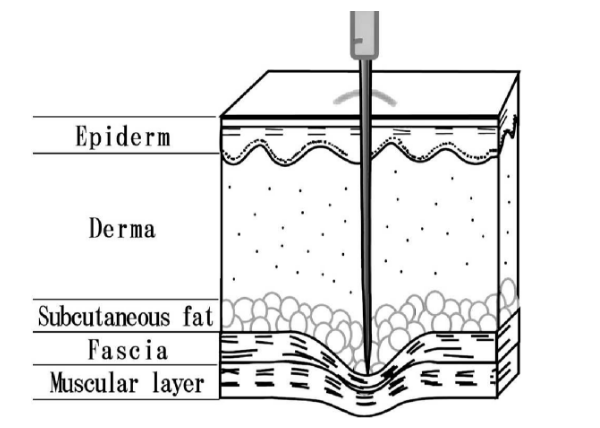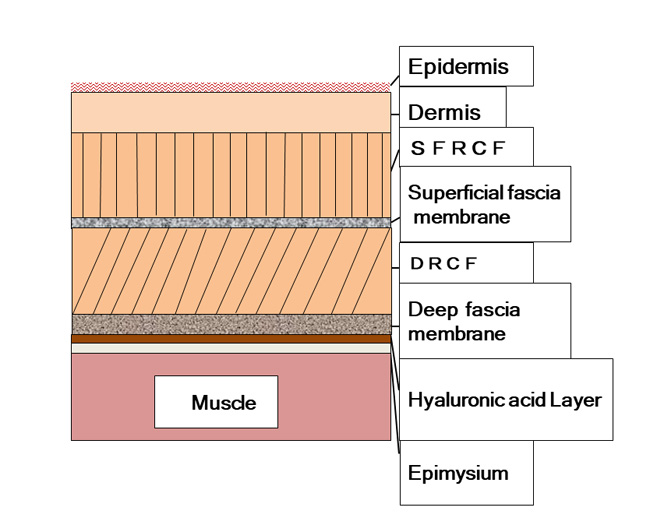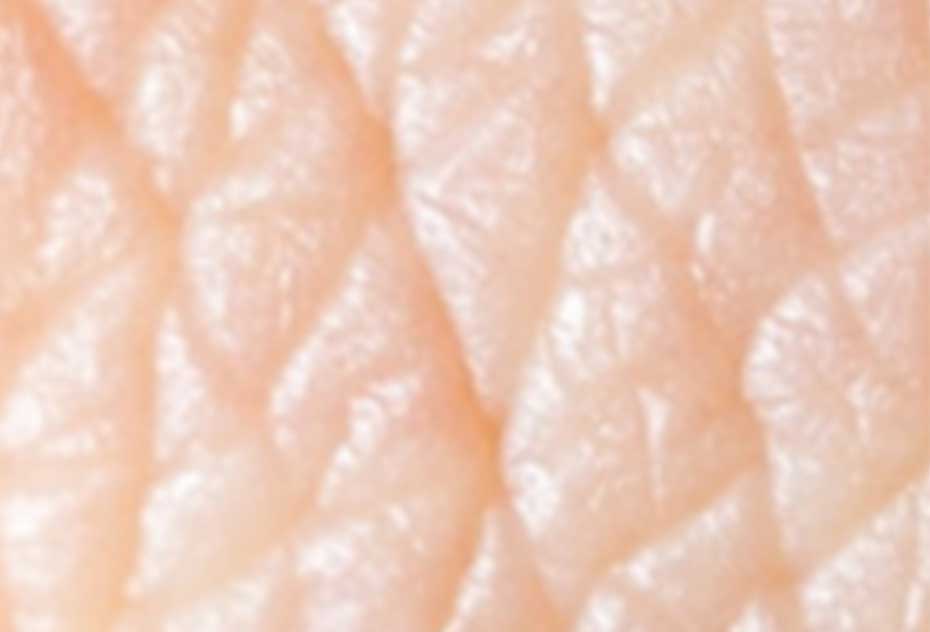Conventional Japanese acupuncture primarily targets the body`s outermost layer of skin for shallow needling, touch stimulation and heat stimulation etc. The efficacy of such methods is corroborated by both anatomical and physiological fact, scientific research data as well as evidence gleaned from their use in clinical practice.
Below I will explain the basic physiological function of skin and also include the various findings from related studies on the matter. With this I hope to establish the various benefits to be had from shallow needling.
1. Anatomy and physiology of the skin
For a better understanding of the effects of stimulation to the skin (and no deeper) it is important to first establish the key principle regarding the anatomical and physiological characteristics of what is ACU-KINESIS` main target, the skin.
The average total surface area of an adult`s skin is roughly 1.6m² and the total weight is around 3kg which accounts for 16% of total body weight.
The skin consists of three layers of tissue; the epidermis, the dermis and the subcutaneous tissue (Dia.9)
Epidermis: This layer`s thickness is 0.06~0.2mm. It is mainly made up of keratinocytes which act as a barrier preventing water from passing, thus acting to maintain the skin`s moisture.: It is often likened to a “plastic bag containing water” which, while the body`s skeletal structure and musculature control the body`s posture, is still able to adjust it`s shape to accommodate postural changes.
As you can see in dia.10 the skin surface has what are called Sulci Cutis and Crista Cutis so when the skin is moved by an outside force, the distance between Sulci Cutis is able to allow for the movement and so, accommodate any movement in the joints.
Sensory receptors such as Merkel cells (Dia.11) are located between the Epidermis and Dermis levels.
Dermis: Thickness is 1mm~3mm. It forms a web-like structure from collagen fibers that maintain the skin`s elasticity and strength. There are free nerve endings that act as sensory receptors. Meissner`s corpuscles respond to touch. Ruffini corpuscles register continuous deep pressure (Dia.11).
Subcutaneous tissue: This is the deepest layer of connective tissue in the skin. It is usually over 10mm thick. It contains stores of fat (called subcutaneous fat) that work to retain body heat and provide cushioning from falls. As well as sensory free nerve endings, Pacini corpuscles (Dia.11)work to register movement by their receptiveness to vibration.
Superficial fascia: Superficial Fascia is not part of the layers of skin but, due to it`s location between subcutaneous tissue and muscle it helps to allow muscle to slide smoothly independantly of the subcutaneous tissue during muscle contraction.
From the above facts, it can be seen that stimulation to the skin can be significantly effected by press needling which can, in turn, have a great impact on the body as a whole.
2. Basis for the therapeutic effect of Press Needling
As Chinese acupuncture has become increasingly popular throughout the world, notable characteristics such as referred sensations, tingling and numbness have also become accepted evils, to the point where needling through to beneath the fascia has also become the norm in many circles. One by-product of this is that for shallow needling techniques that target the skin, efficacy testing has not been conducted sufficiently. The benefits of press needling are still largely unknown as a result.
However, with the help of recent advances in scientific research in dermatology, the link between the skin and the body`s kinetic function (and the effect acupuncture has on these) are becoming more widely acknowledged. To help further understanding of the phenomena that is our body`s skin, I hope to show the effectiveness of press needling by the following research data.
Subcutaneous Polymodal Receptors and Acupuncture Stimulation Research
Between 1990 and 2006 Professor Takao Kumazawa (Reseach Institute of Environmental Medicine Nagoya University) and Yasuzou Kurono (Toyoigaku kenkyujyo) combined to study the effects of mechanical stimulation on polymodal receptors. They discovered that while 60g stimulation resulted in a fall in nerve activity, a considerably weaker 20g stimulation brought about a constant level of nerve activity.
They concluded that the skin`s sensory receptors (polymodal receptors being the pain receptors) were greatly influenced by the therapeutic effects of acupuncture.
Pressure To the Muscular Fascia and the Effects on the Autonomic Nervous System
The study conducted by Yasuzou Kurono(Toyoigaku kenkyujyo) concluded that `acupuncture to CV17 increases the heart`s vagus nerve component which affects changes in heart rate. Acupuncture to CV16 has no effect`.
In the 2011/1/6 edition of “Autonomic Neuroscience : Basic and Clinical” it was shown that if a needle was inserted into the muscular fascia (but not through it) and a pressure of 20g then applied ( as in dia.12) close inspection to changes in heart rate proved an enhanced level of activity in the parasympathetic nervous system.
These conclusions proved to be a breakthrough in the way people outside Japan defined the optimal method of stimulation in acupuncture. It also reinforced the fact that a shallow insertion to the subcutaneous level (pressure stimulation to fascia) can greatly be of therapeutic effect.

References)Kurono, Y., Minagawa, M., Ishigami, T., Yamada, A., Kakamu,T,. Hayano,J., 2011. Acupuncture to Danzhong but not to Zhongting increases the cardiac vagal component of heart rate variability. Autonomic Neuroscience: Basic and Clinical.161,116-120
Research on the effect Skin has on the Movement of the Joints
Professor Tsutomu Fukui(Chukyo Gakuin University Japan)in Oct 2010 described how the skin, in his study “The Kinetics Of Skin”, if guided or manipulated, may influence the range of motion of joints as well as the body`s inner alignment and consequently greatly influence movement. Professor Fukui went on to establish the existence of basic principles connecting skin to body movement.
“The Living Electrical Net” that is the Meridians IS the Fascia.
“The Spark in the Machine: How the Science of Acupuncture Explains the Mysteries of Western Medicine”
Author: Dr. Keown Daniel
https://www.youtube.com/watch?v=YnQLaM7VnZY
Dr. Daniel Keown in his book “A Living Electric Net” found that a weak electrical charge produced in the body was central to the body`s ability to regenerate and heal itself. Dr. Keown equated this electrical charge to what is known as “Qi” in Oriental Medicine. This charge of Qi was found to travel along the body`s fascia.
Our fascia is a fibrous connective tissue that can be found in all our body`s components (nerves, muscles, blood vessels, organs, bones and tendons etc.) enveloping them all like a vacuum pack in an intricate three-dimensional network, the elasticity of which enables movement and sensitivity of the skin.
The collagen in the fascia is of a triple helical structure that has it`s own unique conductivity which, with the help of the Piezo electric current effect, goes to produce the electric current within the aforementioned “Living Electric Net”.
Furthermore, Dr..Keown states that the meridian points along the body`s meridians are recognized in the field of embryology as, not only located nearby vital organization centers (OC`s), but also located in areas with high propensities to conduct electrical current.
The meridians are, as we have shown above, electrically conductive fascia, and as meridian points are too, then with merely the shallowest needling we can get a therapeutic effect.
Involvement of electric double layer and membrane potential change
With a metal needle we first make contact and then insert to a fine degree in shallow needling. This brings together two separate electrical fields to form a double electrical layer. This will bring about a change in the electric field of the outermost layer of the skin where keratocytes are to be found. A change in the membrane potential of these keratocytes is relayed through to the fascia where, again, a change in membrane potential occurs. This chain reaction in membrane potential is then passed down through to the nervous system locally and then registered in other parts of the body.
References)
“The Intelligent Skin – Our Organ That Can Think!”
Kashikoi Hifu: Shikō Suru Saidai No Zōki (Japanese) Paperback
Shinsho – 2009/7/1
Author: Mitsuhiro Denda (Shiseido Research Center, Doctor of
Engineering)
From the outermost skin down to the fascia, the phenomena that is membrane potential change and it`s role in bringing about a therapeutic effect has, I hope, thus been established as fact.
The Total Skin – Minute Connective Tissue Fiber Network
The French plastic surgeon Jean-Claude GUIMBERTEAU (http://www.guimberteau-jc-md.com/en/index.php) succeeded in getting high resolution endoscopic pictures of living tissue. This showed the structure and function of living fascia and how a vast network of minute fibers connected the endless components from the skin at the surface through to the organs to help create the whole body`s structural system.
ACU-KINESIS targets our fascia`s minute fibrous network. I believe that the anatomical evidence above helps to show how effective press needling can be in bringing a therapeutic effect.
ACU-KINESIS (Dry press needling) is literally, kinetic acupuncture therapy to the skin.
With this I hope to have shown the benefits that shallow press needling can bring to clinical practice.
References)
Architecture of Human Living Fascia: The Extracellular Matrix and Cells Revealed Through Endoscopy – 2015/10/19 Author: Jean-claude Guimberteau,Colin Armstrong




